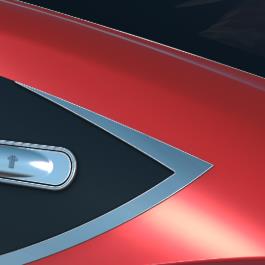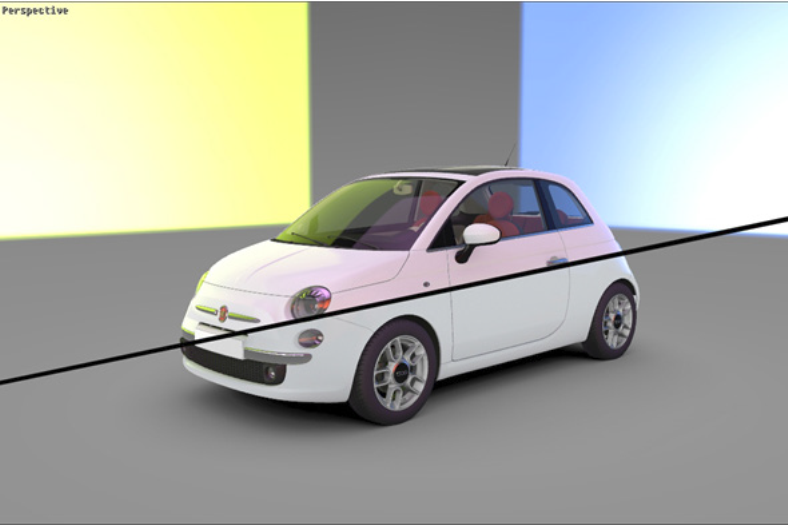Environment Properties (Editor)
The Environment Properties ![]() is an editor used to modify the properties of the active lighting environment.
is an editor used to modify the properties of the active lighting environment.
Certain HDR environment properties are updated in real time as they are modified. These properties are indicated below.
General Properties
General Properties:
| Property | Description |
|---|---|
| Name | Displays the name of the environment. This name can be changed by providing a new name in this field. Use the Enter key to validate any changes. |
| Gamma | Allows you to change the gamma value of your image. Useful in some cases for correcting the gamma value of the imported HDRI image. |
| Saturation | Allows you to adjust the color saturation of the environment image. Its value varies from 0 (environment image in black and white) to 1 (environment image in saturated colors). This property can be adjusted in real time. |
| Mapping Type | Allows you to define the projection method for the type of HDRI image. |
| Invert | Allows you to invert the projection of the environment image. |
| Default Orientation | Initializes the orientation of the environment in order to position it correctly with regard to the product. |
Diffuse:
| Property | Description |
|---|---|
| Exposure Correction | Allows you to adjust the influence of the exposure of the environment on the diffuse layer of a material. It is a coefficient applied to this contribution. This property can be adjusted in real time. |
| Lightmap Coloration | Allows you to adjust the influence of the environment color on the diffusion of the materials using lighting textures. |
Specular:

Figure 28 : Reflection of an environment featuring a high intensity area in a specular material without the High quality filtering option.

Figure 29 : Reflection of an environment featuring a high intensity area in a specular material with the High quality filtering option.
Background:
| Property | Description |
|---|---|
| Alternative background map | Allows a high resolution texture in a low dynamic range format (JPG, PNG...) to be used instead of the HDR environment for environment materials. |
| Exposure Correction | Allows you to adjust the influence of the exposure of the environment on the background. Its value is a coefficient applied to this contribution. This property can be adjusted in real time. |
| Altitude | Allows you to adjust the altitude of the background. |
| Resolution | Allows you to define the resolution of the image used for the background. |
The image below illustrates the impact of the general properties on the render:

Parallax Correction
Reflections generated by a local environment are calculated from the environment's position. However, the observer's position is often different from the environment's position. This may produce a visible difference between the physically realistic reflection of the environment and the reflection actually observed in the scene.
Parallax correction uses proxy surfaces in order to correct for the shift due to the use of different reference points for the observer and the environment.
| Property | Description |
|---|---|
| Type |
The type of proxy surface to use:
The settings for each type of proxy surface are discussed below. |
| Automatic adjustment (...) | When a box or hemisphere proxy surface is used, Patchwork 3D Design can estimate its required volume in order to match the environment zone as closely as possible. Run this operation using the ... button. It may be necessary to fine-tune the results. |
| Gizmo | Show or hide the highlighting of the proxy surfaces. |
Box
Use a box as a proxy when the space that should be used for the environment is mostly box-like.
Boxes are always aligned on the grid. They are defined by their minimum and maximum values along the X, Y and Z axes.
In the corresponding fields, enter the minimum and maximum coordinates along the X, Y and Z axes.
Hemisphere
Use a hemisphere as a proxy when the space that will be used for the environment is similar to a hemisphere shape.
A hemisphere is defined by the length of its radius and by the position of the hemisphere's central point.
Provide the coordinates for the central point, and indicate the length of the radius.
Local Environment Properties
Local environment properties set the capture zone for a local environment.
| Icon | Property | Description |
|---|---|---|
| Product | Associate the environment with an existing product. Drag and drop the product onto this field. | |
| Dynamically rebuild when configuration changes | Activate automatic updating for the local environment when changing configurations. This insures visual coherence in the reflections of geometries, colors and lighting in the scene when the displayed configuration is modified. | |
| Position | Set the origin point at which the local environment will be captured by providing the origin's XYZ coordinates. | |
|
|
Display and move the capture box | The capture box makes it easier to visualize the zones from which the local environment images are going to be captured. It can repositioned with the mouse. |
|
|
Pick the capture origin | Set the origin point of the local environment capture in the viewport using the eyedropper. The X, Y, and Z values of the clicked point are automatically entered in the Position fields. |
|
|
Refresh environment | Update the environment by recalculating the images captured by the local environment box. |
| Radius | Adjust the size of the capture box. | |
| Resolution | Block the resolution of the environment texture at a chosen resolution. Select the desired resolution from the list. | |
| Exclude surfaces with tags |
If the surfaces of an object around which an environment local is assigned have been tagged, they can be ignored by the local environment. Provide the tags of these surfaces here. For more information on tags, see Tag Manager. |
